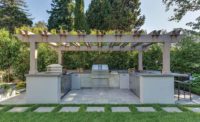
Photo credit: photos courtesy of Reuben Flax, SFA, Sinai Marble & Granite, Baltimore, MD
Moderated by Michael Reis
Q: How do you make true radius cuts without a CNC machine? Right now, I use a grinder and get them close, but they are not near perfect. I explain this to my customers who want a radius before we go ahead. This is very time consuming, and we still get flat spots on it.
Mark Meriaux, The Granite Shop, Smyrna, GA: There are numerous ways that manual-fab shops can create complex curves without a CNC.
Layout tips:
1. For large radii, you can lay out the outside corner points and the center apex, and then use a flexible edge to mark a smooth curve. Some shops use a strip of Luan plywood or an aluminum straight edge to bend and lay out a smooth curve.
2. For small radii, we have used a number of items that already exist in the shop, such as the inside of a masking tape roll (1.5-inch radius), paint can/bucket lids and even diamond blades of various diameters.
Actual fabrication:
1. Rough the shape to within 1/8 inch with an aggressive diamond blade. This can be a regular or concave turbo blade on a saw or grinder.
2. Refine the shape with low-grit grinding wheels. Use the flat face of a 30- or 60-grit wheel to grind closer to your layout line. For inside radii, use a drum-shaped tool or Z-bit (we keep various sizes on-hand) to get smooth inside corners.
On the smaller outside corners, the most common mistake that I notice is out-of-squareness around the radius. Any beginning fabricator should keep a small carpenter’s square handy to check this during the initial shaping process.
Dustin Braudway, SFA, Cape Fear Marble and Tile, Inc., Wilmington, NC: When doing outside radius -- large or small -- it takes a skilled fabricator with a good mindset to perform such a task. These are not the types of tasks that you want to assign a green polisher.
Just as Mark Meriaux said, we work as follows:
1. We figure the size of the top and establish the radius with the customer prior to the templater’s jobsite performance.
2. Templater confirms sizes and works hand-in-hand with the owner to achieve the look that the owner is looking for.
3. Figure out the radius start point. Sometimes it is as simple as an arch where the end points come out 6 inches at each end, and the mid point is 18 inches.
We use a 1/8- x 2- x 96-inch aluminum straight edge to bend and connect the points established. After marking the outline, we then would cut the radius up to about a 1/16 inch away from the line. After the initial cutout, we then would grind the radius up to the established line. We do keep a small 6-inch framing square with us to keep square and plumb on the edge.
Now that we digitally template and plot vinyl templates, we can digitally capture the cabinets, planters, stairways, etc., and then import the .DXF and manipulate the radius, splines and arches in AutoCAD. We are able to cut and CNC these shapes, but for an all-manual shop with digital template and plotting capabilities, they could easily plot the vinyl and trace the shapes on the slabs. Again, it would still take a skilled fabricator to cut and grind back to the shape of the template without getting flat spots.
Mark Mihalik, SFA, Counterparts, LLC, Delaware: We do the same as Mark Meriaux mentioned. However, on large outside radii and arcs, we make a template out of MDF, sand it and convert it to solid surface or UHMW to use as a pattern for a Z-wheel bit with a top bearing to follow. With the pattern, almost anyone can do it.
Phil Auzas, SFA, Desert Sun Natural Stone Inc., Arizona: If we are fabricating a radius for a laminated edge, we will lay out a piece of roofing paper on the slab, mark out the radius that we need with a piece of Luan and cut it out with a razor blade.
Using the roofing paper template, we can draw the radius and then duplicate the radius again 1.5 inch away for the lamination.
The nice thing about the template is that you can check how uniform it is by drawing the outline, and then flip the template upside down to see how off you are.
We typically cut our radius with a small 4-inch hand saw. I step-cut the radius a little at a time and take my time. When we are done, it is very close to the preferred size.
Chris Yaughn, Yaughn Countertops, Statesboro, GA: Have a local solid surface shop cut it for you in plywood or MDF or stainless steel scraps. Trace the template and cut pretty close with a blade. Clamp on the template, and run the “Reubenator” flush-cut blade/bit device (a tool developed by Reuben Flax of Sinai Marble & Granite of Baltimore, MD).
Reuben Flax, SFA, Sinai Marble & Granite, Baltimore, MD: To make a true radius in our shop, we pull out the wood router and compass attachment, and we set the points to equal the desired radius on a piece of 3/4-inch, cabinet-grade plywood. Then we cut the radius, creating a perfect arc.
From there, we trace the plywood template onto the stone with a White-out pen and cut the radius with a straight 5-inch blade for outside curves in a series of step cuts, usually three for 3-cm stone, but more if the radius is especially tight.
For inside curves, we use a 5-inch contour blade because it makes it easier to follow a line and not worry about undercutting the good side of your cut.
For the trace and cut, it’s ok to be within 1/8 inch of the line, but not more than that, or else there’s too much stone to remove in the next step.
The next step is to re-position your plywood template and clamp it down firmly, then run a stone router with the “Reubenator” pattern tracing bit. To better understand a “Reubenator” bit, think of a really big Z-wheel made out of a bunch of stacked 5-inch-diameter dry cut blades on a shaft. When spun in a router, it eats stone very quickly. You can make your own at a local machine shop to fit your router.
The “Reubenator” bit leaves a very course edge that would take a lot of time to hand polish, so from there I use a 60-grit segmented Z-wheel on the same plywood template. I sanded down the diameter of my 60-grit Z-wheel’s guide bearing by about 1/64 inch on a belt sander by holding the bit at an angle to the belt sander while it is running and allowing the bearing to spin while it is being sanded down. This allows you to keep the bearing round and also reduce the diameter, or you could have a local machine shop do it for you.
From there, you can use one more Z-wheel of a finer grit, like 100 or 150, or follow with your edge profile bits.
We usually start hand polishing after the 600-grit wheel. This technique sounds long on paper, but is actually pretty quick and produces perfect radii that will rival a CNC any day of the week.
For kicks, we actually made a cool round table on our bridge saw by plunging the saw 1/8 inch at a time and just spinning the table with the stone roughly centered. It took about 20 minutes to create a perfect circle with straight sides ready to polish.
Now that we’re into our new shop, I’m using designated routers with each of the three mentioned Z-wheel bits in them, so you just pull them off the shelf in series and cut your sink. It takes about 20 minutes from start to finish going through the saw and all three router bits, and then you can polish from 100 grit and up.
Stratis Sylvyn, Artistic Stone, Laurel, MT: I get no flat spots by using a wood router attached to a straight edge, as a trammel on tempered masonite. I then transfer to the stone via paint pen. Cut as close as possible to the line with a 5-inch turbo blade while still leaving the line. Then replace the masonite template and run a powerful wood router with an aluminum base plate, with water and a 2-inch collar with a couple of zero tolerance bits. Then proceed with either a larger stone router with a profile bit or finer zero bits. Finish to a polish.
Ravin Perinpanayagam, San Diego, CA: I thought I would add to this forum, although with a couple of months of “hobby” fabricating, I’m not in the same league as everyone else here. I also dabble in metalworking, and I’ve found that bits of steel left over from projects come in really handy for working with stone. As for radius shaping, I have a few pieces of steel pipe left over from other projects that work really well for this. Just clamp and run the Z bit so that the bearing rides on the pipe. You can go down to your local steel yard and get various sections of steel pipe or tube. If they are remnants, they will pretty much give them away for next to nothing. Take them home, cut with a bandsaw, and you have a template for a radius. This will only work for small radii.
Brian Briggs, Granite Guys, Inc., Ft. Pierce, FL: Before our vinyl plotter and CAD program, we used a 2- x 15- x 3/16-inch piece of aluminum. Set it where you want your three points of the radius, start in the outermost or innermost point (innermost for a “kidney bean”) and move to the other two points. Mark with pencil, and then cut and grind.
Scott McGourley, Kasco Stone, Tampa, FL: Layout is paramount. If your layout is incorrect, it is very easy to get flat spots. A $400 vinyl plotter on Ebay will save you a lot of time in this regard, and it will also produce a perfect radius.
There is almost nothing harder to polish than a very shallow radius edge. For beginners, I also recommend a template, “Reubenator” and Z bit, then follow up with 3-inch turbo pads. For an accomplished fabricator, a flush-cut diamond blade followed up by 3-inch turbos will work. If you get a flat spot, you have to work it all the way out to the end. It is very easy to get one. By using hard turbo pads, you can feel the slightest dip in the edge.
I do not suggest allowing green polishers to attempt this type of edge.




